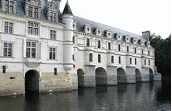|
The Pompidou Centre was completed in 1978 by the architects Renzo
Piano of Italy and Richard Rogers of England, and by the engineering firm of Ove Arup and
Partners of England.
The structure forms a huge transparent box with the exposed frame of tubular steel columns
carrying trusses spanning the width of the building.
All of the main mechanical systems are conspicuously place on the outside with the
escalators in clear plastic tunnels. Other systems are painted in different colours
- elevators painted red, giant tubes for air are painted blue, water is green and
electricity is yellow.
Considerable controversy arose over the assertive industrial style of the Pompidou Center,
as the bold exoskeleton architecture severely contrasts with surrounding houses in the
heart of an old section of Paris near the H?tel de Ville.
However the centre has been hugely successful, with its many art exhibitions and the
National Museum of Modern Art, attracting more than 160 million people since its
inauguration.
Unfortunately, with around five times more visitors per day than was originally
anticipated, the wear and tear resulted in the centre having to be shut down for
renovations. It was reopened in 1999 and part of the building is kept open for
temporary exhibitions, and you can still take the escalators to the top floor for a
marvellous view of Paris.
The Beaubourg Plaza in front of the Centre remains a very animated area with its jugglers,
mimes and humorists from all over Europe continuously attracting a crowd. This Paris
tradition, which survives from the Middle Ages, can also be spotted in other areas like
Saint-Germain-des-Pr?s and the Place de la Contrescarpe, which is near to the Pantheon.
The Beaubourg area is especially lively at night, offering visitors plenty of bars and
restaurants.
|
|


